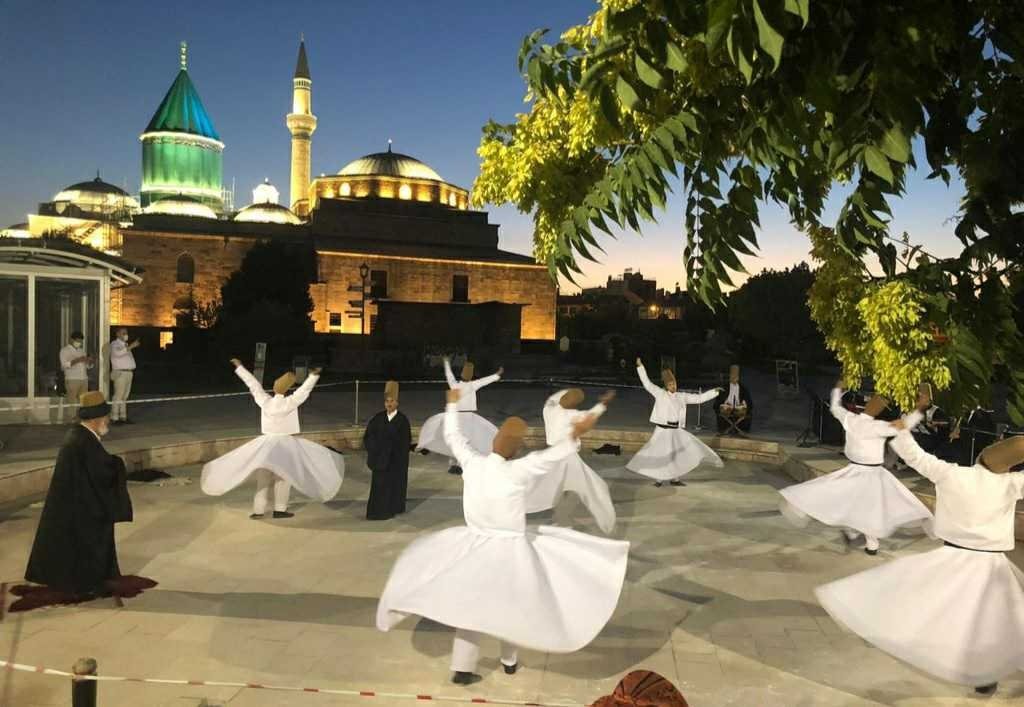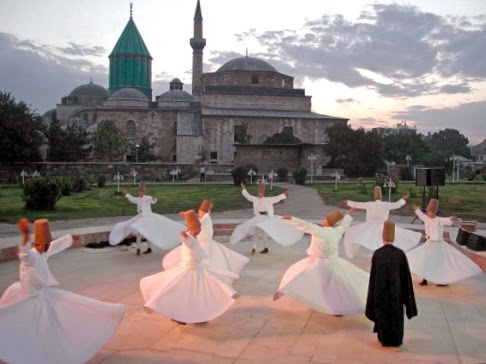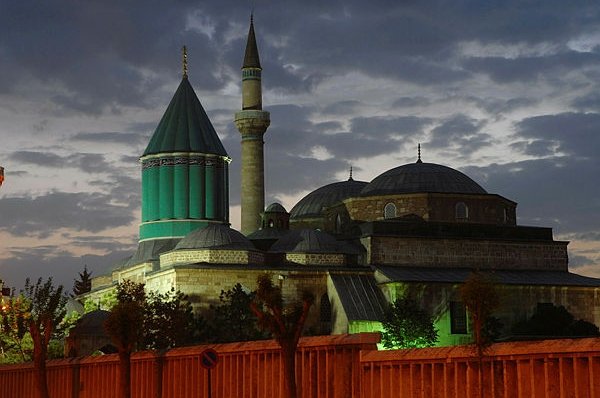Dance, Love, Poetry: Unveiling the Mevlana Museum's Magic

Overview of the Mevlana Museum and its significance
The Mevlana Museum, also known as the Mevlana Museum of Anatolian Civilization, is located in Konya, Turkey. It is a beautiful and historically significant site that attracts visitors from all over the world. The museum is dedicated to the life and teachings of Mevlana Rumi, a 13th-century Persian philosopher, poet, and Sufi mystic.
Brief history of Mevlana Rumi and his poetry
Mevlana Jalal ad-Din Rumi, commonly known as Rumi, was born in 1207 in Balkh, now part of Afghanistan. He was a prominent Islamic scholar and theologian who became a renowned poet. Rumi's poetry is characterized by its deeply spiritual and profound themes, which resonate with readers today.
Rumi founded the Mevlevi Order, also known as the Order of the Whirling Dervishes, which emphasizes spiritual growth through music, poetry, and dance. The Mevlevi Order's rituals involve Sufi whirling, a form of meditation and prayer that aims to attain spiritual enlightenment.
The Mevlana Museum houses many artefacts related to Rumi's life and teachings. It includes manuscripts, calligraphy, musical instruments, and personal belongings of Rumi and his disciples. One of the most notable displays is Rumi's tomb, which is the museum's centrepiece and serves as a place of pilgrimage for many Muslims.
The museum also features a library with a comprehensive collection of Rumi's works, translations, and scholarly research. It is a resource for scholars and enthusiasts interested in studying Rumi's poetry and spirituality.
The Mevlana Museum is not only a testament to the life and teachings of Mevlana Rumi but also a symbol of the enduring legacy and impact of his poetry. It allows visitors to immerse themselves in Rumi's world and gain a deeper understanding of his philosophy and spirituality. Whether you are a fan of Rumi's poetry or simply interested in exploring Turkish culture and history, a visit to the Mevlana Museum is a must.

The Whirling Dervishes of Mevlana
Explanation of the Whirling Dervishes and their connection to Mevlana
The Whirling Dervishes, also known as the Mevlevi Order, are an integral part of the Mevlana Museum and its significance. The Order was founded by Mevlana Jalal ad-Din Rumi and is dedicated to his teachings and spiritual practices. These practices include music, poetry, and dance, with Sufi whirling being the most well-known ritual.
The spiritual practice of whirling and its symbolism
The whirling dance performed by the Dervishes is a form of meditation and prayer to achieve a higher spiritual enlightenment. The spinning motion represents the rotation of the Earth and the galaxies, symbolizing the constant movement and flow of the universe. It is believed that through this practice, the Dervishes can transcend the material world and connect with the divine.
During the whirling ceremony, the Dervishes wear long white robes and tall conical hats, symbolic of their spiritual journey. The white robes represent purity and simplicity, while the hats represent the tombstone and the ego's death. The Dervishes seek to detach themselves from worldly desires and surrender to a higher power by spinning in a counterclockwise direction.
The whirling dance also involves specific music and chanting, enhancing the spiritual experience. The rhythmic music and repetitive movements help the Dervishes attain a trance-like state and focus their minds solely on their connection with the divine.
The Whirling Dervishes of Mevlana play a crucial role in the Mevlana Museum and its tribute to Mevlana Rumi. Their whirling practice is visually captivating and a profound spiritual experience. Visiting the museum provides an opportunity to witness this unique form of devotion and gain a deeper understanding of Mevlana's teachings and the significance of the Mevlevi Order.

The Mevlana Museum: Architecture and Design
Description of the museum's architecture and layout
The Mevlana Museum is located in Konya, Turkey and is a testament to Mevlana Jalal ad-Din Rumi's rich history and spiritual legacy. The museum is housed in a stunning complex that beautifully showcases the architectural styles of different periods. As you enter the museum, you are welcomed into a serene courtyard adorned with lush gardens and intricate tilework. The courtyard is a peaceful oasis where visitors can take a moment to reflect and soak in the ambience before exploring the rest of the museum.
You will find a mixture of Ottoman and Seljuk architectural elements inside the main building. The museum comprises several rooms and halls designed with attention to detail and reverence for Mevlana's teachings. The museum's layout allows for a seamless flow from one area to another, enhancing the overall visitor experience.
Significant elements and decorations within the museum
One of the most significant elements within the museum is the tomb of Mevlana Rumi, located in a beautifully decorated room. The tomb is a place of deep veneration and attracts visitors from all over the world. The room is adorned with intricate tile work, calligraphy, and detailed ceiling designs, creating a mesmerizing ambience.
Another important feature within the museum is the exhibition of Mevlana's items and manuscripts. These relics provide a glimpse into the life and teachings of Mevlana and offer a unique insight into his spiritual journey. The museum also houses a library containing a vast collection of books related to Sufism, poetry, and philosophy.
The museum's interior is adorned with stunning stained glass windows, which fill the rooms with an ethereal glow. These windows depict various scenes from Mevlana's life and teachings, adding to the overall spiritual atmosphere of the museum.
The Mevlana Museum provides visitors with a captivating architectural experience that perfectly complements the spiritual significance of Mevlana Rumi and the Whirling Dervishes. The careful design and attention to detail in the museum's architecture and decorations create a serene and immersive environment for visitors to explore and connect with the teachings of Mevlana.

Poetry of Mevlana: Love and Sufism
Exploring Mevlana's poetry and its themes of love and spirituality
Mevlana Jalal ad-Din Rumi, known simply as Mevlana or Rumi, was a respected spiritual leader and a talented poet. His poetry is a testament to his deep love for God and his teachings on the path of Sufism. Mevlana's poems are characterized by their profound spirituality, themes of love, and their ability to touch the hearts of readers from all walks of life.
Mevlana beautifully expresses divine love and the soul's longing for union with God in his poetry. He often uses metaphors of lovers and beloveds to convey the intensity of this spiritual connection. Mevlana saw love as the driving force behind the universe; his poetry reflects this belief. His words can awaken the dormant love within our hearts and inspire us to seek a deeper connection with the divine.
Mevlana's poetry also explores the theme of spirituality and the soul's journey. He recognizes that enlightenment is difficult and requires discipline, self-reflection, and surrender. Mevlana's verses offer guidance and solace to those searching for meaning. His words encourage introspection and remind us of the importance of inner transformation.
The influence of Mevlana's poetry on Sufism
Mevlana's poetry has profoundly impacted Sufism, a mystical form of Islam that emphasizes the interior spiritual journey. Sufis cherish his poems around the world, and they are often recited as part of their spiritual practice. The rich symbolism and depth of Mevlana's verses resonate deeply with Sufi teachings and have become an integral part of Sufi tradition.
Mevlana's poetry encapsulates the core principles of Sufism, including love, surrender, and the pursuit of spiritual growth. His words inspire Sufis to cultivate a deep connection with God, to be guided by love in all aspects of life, and to let go of their ego to attain true spiritual liberation.
Mevlana's poetry is a source of inspiration and spiritual guidance for people of all backgrounds. His verses continue to touch the hearts and souls of readers, inviting them to embark on a journey of love, self-discovery, and spiritual growth. Through his poetry, Mevlana invites us to awaken to the divine love that resides within us and to connect with the eternal beauty of the universe.

The Melodies of the Ney
Introduction to the Ney, a traditional Turkish musical instrument
The Ney is a traditional Turkish musical instrument with a special place in the heart of Mevlana's poetry and Sufi music. It is a reed flute-like instrument with a hauntingly beautiful sound often associated with spirituality and mysticism. The Ney is made from a type of cane called reed and is played by blowing air into one end while using the fingers to cover and uncover the holes along its length.
The importance of Ney in Mevlana's poetry and Sufi music
The Ney plays a significant role in Mevlana's poetry, symbolising the relationship between the human soul and the divine. Its soul-stirring melodies evoke a longing and yearning for spiritual union with God. Mevlana believed that music, especially the Ney, could transport the listener to a higher state of consciousness, allowing them to connect with the divine essence within themselves.
In Sufi music, the Ney is often accompanied by other traditional instruments, such as the oud, tambur, and daf, creating a mesmerizing ensemble of sounds. This music is an integral part of Sufi rituals and ceremonies, known as Sema, where participants engage in whirling dance to reach a state of spiritual ecstasy. The mystical melodies of the Ney and the synchronized movements of the Sema create an atmosphere of transcendent beauty and unity.
The Ney's melodic range and ability to evoke deep emotions make it an ideal instrument for expressing love, longing, and spiritual yearning in Mevlana's poetry. Its enchanting sound resonates with the readers and listeners, taking them on a journey of self-discovery and connection with the divine.
The Ney holds a special place in Mevlana's poetry and Sufi music. Its ethereal melodies and spiritual significance add another dimension to the profound themes of love and spirituality found in Mevlana's writings. The Ney's haunting sound continues to inspire and touch people's hearts, inviting them to embark on their spiritual journey of awakening and union with the divine.

Dance Performances at the Mevlana Museum
Explanation of the dance performances held at the museum
At the Mevlana Museum, visitors are treated to mesmerizing dance performances that showcase the rich cultural heritage of the Sufi tradition. These performances bring to life the spiritual mysticism and devotion Mevlana and his followers espoused. The dances, known as Sema, are a whirling meditation that seeks to connect the physical and spiritual realms. They are performed by a group of dervishes dressed in long, flowing white robes, symbolizing purity and transcendence.
During the Sema, the dervishes whirl in graceful and synchronized movements, symbolizing the universal rotation and harmony found in the cosmos. It is a visual representation of the soul's journey towards spiritual enlightenment. The hypnotic whirling motions, accompanied by the enchanting melodies of the Ney and other traditional instruments, create an ethereal atmosphere that transports the audience to a state of contemplation and inner peace.
The significance and meaning behind the dances
The Sema dances hold deep symbolic meanings rooted in Sufi philosophy. Whirling represents the individual's journey in search of divine truth and union with God. Just as the planets revolve around the sun, the dervishes whirl around their axis, symbolizing the surrender of the self to the divine presence. It is believed that through this dance, the dervishes transcend their ego and reach a state of spiritual ecstasy.
The white robes worn by the dervishes symbolize their detachment from worldly desires and their desire for spiritual purity. The turning motion signifies the detachment from earthly attachments and attaining spiritual insight and enlightenment. The dance is a physical expression of the inner spiritual journey, inviting the audience to witness and participate in the longing for divine love and union.
The dance performances at the Mevlana Museum encapsulate the essence of Sufi spirituality and the teachings of Mevlana. With their graceful movements, the whirling dervishes invite us to embark on our spiritual path and seek a deeper connection with the divine. It is a mesmerizing experience that reminds us of the power of music and movement to transcend physical boundaries and touch the depths of our souls.

Exhibits and Artifacts at the Mevlana Museum
Highlighting the collection of artefacts and exhibits at the Mevlana Museum
When visiting the Mevlana Museum, you will have the opportunity to explore a fascinating collection of artefacts and exhibits that shed light on the life and teachings of Mevlana and the Sufi tradition. These exhibits offer a glimpse into the rich cultural heritage and spiritual legacy Mevlana and his followers left behind.
One of the prominent exhibits is Mevlana's personal belongings. These include his clothing, prayer beads, and writings, which provide insights into his daily life and spiritual practices. The exhibition also features a collection of rare manuscripts, including copies of the Quran and other Sufi texts, illustrating the depth and breadth of Mevlana's knowledge and wisdom.
Another highlight of the museum is the display of traditional Sufi musical instruments. These instruments, such as the Ney and the Saz, are integral to Sufi rituals and performances. They create the enchanting melodies that accompany the Sema dance, adding to the ethereal atmosphere and spiritual experience for visitors.
Exploring the historical and cultural significance of the items
Each artefact and exhibit at the Mevlana Museum holds significant historical and cultural value. They are tangible reminders of Mevlana's teachings and impact on the Sufi tradition. By studying these items, visitors can gain a deeper understanding of the principles and practices of Sufism.
The personal belongings of Mevlana offer a glimpse into this revered figure's daily life and spiritual devotion. His writings provide insights into his profound thoughts and teachings, inspiring visitors to reflect on their spiritual journey and search for truth.
The displayed manuscripts highlight the depth of Mevlana's knowledge and his commitment to spreading spiritual wisdom. They showcase the importance of knowledge and education in Sufi philosophy, encouraging visitors to seek enlightenment through learning and self-reflection.
The musical instruments exhibited at the museum emphasize the role of music and dance in Sufi rituals. They symbolize the transformative power of music in transcending mundane existence and connecting with the divine. Visitors can hear the enchanting melodies of these instruments during the mesmerizing dance performances, deepening their appreciation for the unity of music, movement, and spirituality.
The exhibits and artefacts at the Mevlana Museum provide a captivating journey into the life and teachings of Mevlana and the Sufi tradition. They offer a tangible connection to the rich cultural heritage and spiritual depth of Sufism, inviting visitors to explore their spiritual path and seek enlightenment through knowledge, devotion, and contemplation.

Events and Festivals at the Mevlana Museum
Overview of the festivals and events held at the museum throughout the year
When visiting the Mevlana Museum, not only will you have the chance to explore the captivating exhibits and artefacts, but you will also have the opportunity to participate in various festivals and events that take place throughout the year. These events offer a unique and immersive experience, allowing you to connect with the Sufi tradition and celebrate the spiritual legacy of Mevlana.
One of the major events held at the museum is the annual Mevlana Commemoration Ceremony, which takes place in December. This festival attracts thousands of visitors worldwide who come to pay tribute to Mevlana on the anniversary of his death. The ceremony includes religious rituals, poetry recitations, and mesmerizing Sema dance performances. It is a truly magical and spiritual experience that showcases the devotion and reverence for Mevlana and his teachings.
Another significant event is the Festival of Whirling Dervishes held in October. This festival brings together Sufi groups from different parts of Turkey and the world to celebrate the art of Sema dance. The festival's highlight is the mesmerizing performance by the whirling dervishes, who spin in meditative circles to achieve a spiritual trance. It is a visual spectacle that captures the essence of Sufism and leaves a lasting impression on all who witness it.
Popular annual celebrations and their importance
Throughout the year, the Mevlana Museum also hosts a variety of other celebrations and events that showcase the cultural and spiritual heritage of the Sufi tradition. These include music festivals, poetry readings, and Sufi philosophy and practice workshops. These events provide artists, scholars, and spiritual seekers a platform to come together, share their knowledge and talents, and deepen their understanding of Sufism.
One such celebration is the Mevlevi Music Festival, which features performances by renowned musicians specializing in Sufi music. The festival celebrates the mystical power of music and its ability to uplift the soul and connect individuals with the divine. It is a joyous occasion filled with mesmerizing melodies and heartfelt performances that touch the hearts of all who attend.
Overall, the festivals and events at the Mevlana Museum offer an immersive and unforgettable experience for visitors. They provide a glimpse into the vibrant culture and spiritual traditions of Sufism, allowing individuals to connect with their spirituality and find inspiration in the teachings of Mevlana. These events serve as a reminder of the timeless wisdom and universal values that continue to resonate with people from all walks of life.
